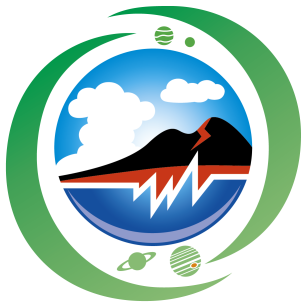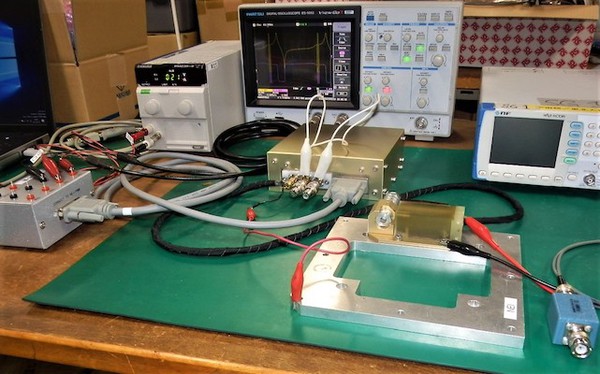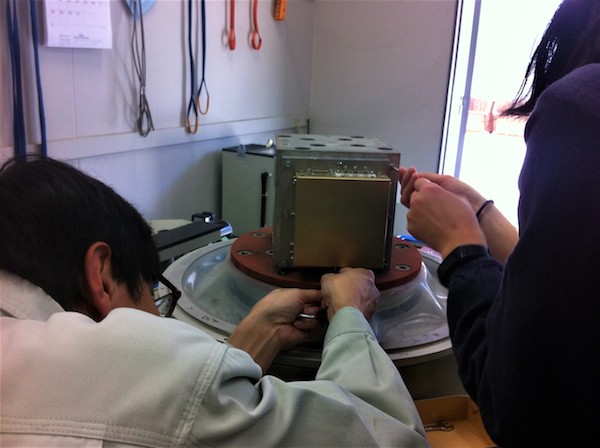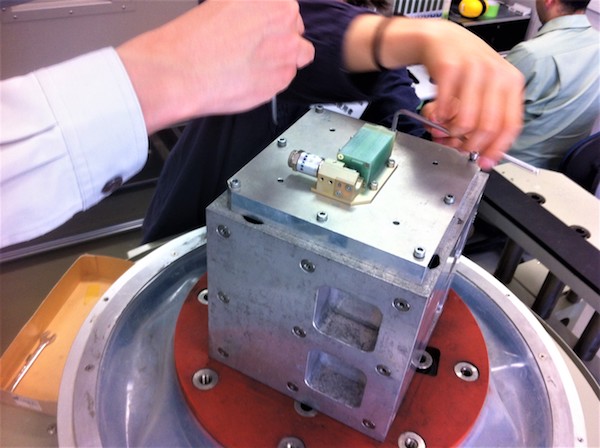Topics 2017.08.09
Sounding rocket experiment of outflowing ions in the cusp region
Figure 1: Pre-flight test of NEI/PWM
Sounding rocket experiments are the unique method capable of in situ observation of ionospheric plasma at an altitude higher than 80 km. The ionosphere is a transition region from the lower atmosphere, consists of neutral gas, to the magnetosphere, dominated by collision-less plasma. Since the ionosphere is dominated by both neutral and plasma particles, collision of both constituents makes the behavior of ionospheric plasma unique and fascinating research subjects. Since 1970's, Space and Terrestrial Plasma Physics Laboratory has been contributing sounding rocket experiments conducted by JAXA/ISAS, collaborating with researchers and engineers of other universities and institutes.
SS-520-3 sounding rocket experiment will be carried out on December 2017 at Svalbard, Norway, for the investigation of the mechanism of outflowing ions in the cusp region. Cusp is the region magnetically connected to the boundary between the magnetosphere and solar wind, where ionospheric ions outflow from the Earth through the heating of ionospheric plasma due to the energy input from the solar wind. Although previous studies suggested the importance of plasma waves often observed at an altitude from a few hundred to a few thousand km, the heating/acceleration mechanisms of ionospheric plasma in the cusp region has not been fully understood. The SS-520 series is categorized as a sounding rocket experiment capable of the measurement of the highest altitude range among sounding rockets of JAXA/ISAS. The apex of SS-520-3 experiment is planned to be 800 km.
Space and Terrestrial Plasma Physics Laboratory is in charge of the development of Number density of Electron measurement by Impedance probe/Plasma Wave Monitor (NEI/PWM; Figures 1-3) and Wave-Particle Interaction Analyzer (WPIA) in the SS-520-3 sounding rocket experiment. Our graduate school students have been contributing the development and pre-flight tests of the instruments. Impedance Probe, an instrument developed by Emeritus Professor Hiroshi Oya, enables us to carry out accurate measurement of the number density of electrons. Impedance Probe has been installed in more than 50 sounding rocket experiments as well as satellites and has been used in a lot of studies revealing the nature of ionospheric/magnetospheric plasma. NEI/PWM onboard the SS-520-3 sounding rocket experiment will contribute the investigation of the outflowing ions by providing accurate electron number density in the cusp region as well as activities of plasma waves in the frequency range from 300 Hz to 20 MHz. The purpose of WPIA is direct measurements of the energy exchange between ionospheric ions and plasma waves in the kHz frequency range in the cusp region. WPIA has also been installed in the ARASE satellite for the exploration of energization and radiation in Geospace. WPIA will try to measure the evidence of the ion energization by plasma waves in the cusp region, which has never been obtained in previous studies. We expect that in situ measurements by SS-520-3 sounding rocket experiment at a site of ion outflow from the Earth will make significant contributions to the thorough understanding of the heating/acceleration mechanism of ionospheric plasma.
Space and Terrestrial Plasma Physics laboratory,
Prof. Atsushi Kumamoto, Prof. YutoKatoh
Figure 2: Preparation of the vibration test of NEI/PWM main unit
Figure 3: Preparation of the vibration test of impedance probe unit



